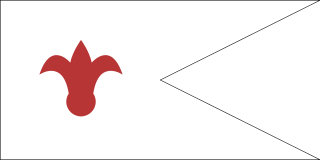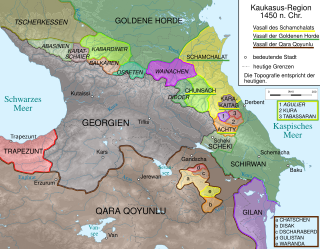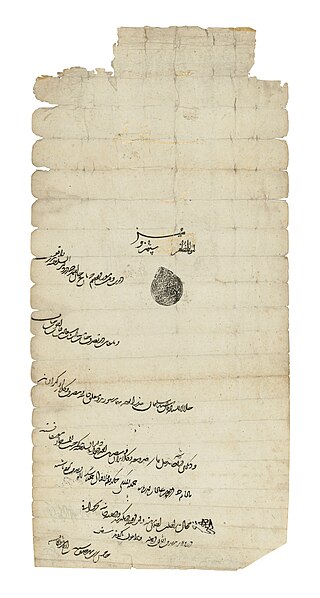
Ismail I was the founder and first shah of Safavid Iran, ruling from 1501 until his death in 1524. His reign is often considered the beginning of modern Iranian history, as well as one of the gunpowder empires. The rule of Ismail I is one of the most vital in the history of Iran. Before his accession in 1501, Iran, since its conquest by the Arabs eight-and-a-half centuries earlier, had not existed as a unified country under native Iranian rule. Although many Iranian dynasties rose to power amidst this whole period, it was only under the Buyids that a vast part of Iran properly returned to Iranian rule (945–1055).

Kakheti is a region (mkhare) formed in the 1990s in eastern Georgia from the historical province of Kakheti and the small, mountainous province of Tusheti. Telavi is its administrative center. The region comprises eight administrative districts: Telavi, Gurjaani, Qvareli, Sagarejo, Dedoplistsqaro, Signagi, Lagodekhi and Akhmeta.

The Battle of Krtsanisi was fought between the army of Qajar Iran (Persia) and the Georgian armies of the Kingdom of Kartli-Kakheti and Kingdom of Imereti at the place of Krtsanisi near Tbilisi, Georgia, from September 8 to September 11, 1795, as part of Agha Mohammad Khan Qajar's war in response to King Heraclius II of Georgia’s alliance with the Russian Empire. The battle resulted in the decisive defeat of the Georgians, capture, and complete destruction of their capital Tbilisi, as well as the temporary absorption of eastern parts of Georgia into the Iranian empire.
Constantine II, of the Bagrationi dynasty, was the 23rd and last king (mepe) of United Georgia from 1478 until his death. Early in the 1490s, he had to recognise the independence of his rival rulers of Imereti and Kakheti, and to confine his power to Kartli. In 1505, Constantine II died, and was succeeded by his son David X.

Khalilullah I, also known as Sultan-Khalil (سلطان-خلیل), was the Shirvanshah from 1418 to 1465. He was the son and successor of Ibrahim I. He was succeeded by his son Farrukh Yasar.

Farrukh Yasar was the last independent Shirvanshah of Shirvan (1465–1500). In 1500, the first Safavid ruler, Ismail I, decisively defeated and killed Farrukh Yasar during his conquest of the area. Descendants of Farrukh Yasar continued to rule Shirvan under Safavid suzerainty, until 1538, when Ismail's son and successor Tahmasp I appointed its first Safavid governor, and made it a fully functioning Safavid province.
Iran and Georgia have had relations for thousands of years. Eastern and Southern Georgia had been under intermittent Persian suzerainty for many centuries up to the early course of the 19th century, while western Georgia had been under its suzerainty for much shorter periods of time throughout history. Georgia especially rose to importance from the time of the Persian Safavids.

The Kingdom of Kakheti was a late medieval/early modern monarchy in eastern Georgia, centered at the province of Kakheti, with its capital first at Gremi and then at Telavi. It emerged in the process of a tripartite division of the Kingdom of Georgia in 1465 and existed, with several brief intermissions, until 1762 when Kakheti and the neighboring Georgian Kingdom of Kartli were merged through a dynastic succession under the Kakhetian branch of the Bagrationi dynasty. Through much of this period, the kingdom was a vassal of the successive dynasties of Iran, and to a much shorter period Ottoman Empire, but enjoyed intermittent periods of greater independence, especially after 1747.

The Shirvanshahs were the rulers of Shirvan from 861 to 1538. The first ruling line were the Yazidids, an originally Arab and later Persianized dynasty, who became known as the Kasranids. The second ruling line were the Darbandi, distant relatives of the Yazidids/Kasranids.

Shaykh Haydar or Sheikh Haydar was the successor of his father as leader of the Safavid order from 1460 to 1488. Haydar maintained the policies and political ambitions initiated by his father. Under Sheikh Haydar, the order became crystallized as a political movement with an increasingly extremist heterodox Twelver Shi'i coloring and Haydar was viewed as a divine figure by his followers. Shaykh Haydar was responsible for instructing his followers to adopt the scarlet headgear of 12 gores commemorating The Twelve Imams, which led to them being designated by the Turkish term Qizilbash "Red Head".

The Kingdom of Kartli was a late medieval/early modern monarchy in eastern Georgia, centred on the province of Kartli, with its capital at Tbilisi. It emerged in the process of a tripartite division of the Kingdom of Georgia in 1478 and existed, with several brief intervals, until 1762 when Kartli and the neighbouring Georgian kingdom of Kakheti were merged through dynastic succession under the Kakhetian branch of the Bagrationi dynasty. Through much of this period, the kingdom was a vassal of the successive dynasties of Iran, and to a much shorter period Ottoman Empire, but enjoyed intermittent periods of greater independence, especially after 1747.

The Turkoman invasions of Georgia also Georgian–Turkoman wars, refers to invasions of various Muslim Turkoman tribes on the territory of the Kingdom of Georgia throughout the 15th century.
Bahram Beg was the 37th Shirvanshah, and ruled over Shirvan under Safavid suzerainty. Despite the enmity that existed between the Shirvanshahs and the ruling Safavid dynasty, Safavid king Ismail I allowed, after his conquest and defeat of Bahram's father Farrukh Yassar, the latter to rule as a Safavid subject.

Sheykh Ibrahim II was the 40th shah of Shirvan.
Khalilullah II was the 41st Shirvanshah, governing Shirvan under Safavid suzerainty between 1524—1535.
House of Derbent or Darbandids was a younger branch of Shirvanshahs that succeeded Kasranids.

Hossein Beg Laleh Shamlu was a Qizilbash officer of Turkoman origin, who occupied high offices under the Safavid king Ismail I and was the first person to serve as the vakil (vicegerent) of the empire.
Gokcheh Sultan Ziyadoghlu Qajar, better known as Shahverdi Sultan, was a Safavid military leader of Turkoman origin who was part of the Ziyadoghlu branch of the Qajars, who served as the governor of Karabakh and Ganja during the reign of king Tahmasp I.

The province of Georgia was a velayat (province) of Safavid Iran located in the area of present-day Georgia. The territory of the province was principally made up of the two subordinate eastern Georgian kingdoms of Kartli and Kakheti and, briefly, parts of the Principality of Samtskhe. The city of Tiflis was its administrative center, the base of Safavid power in the province, and the seat of the rulers of Kartli. It also housed an important Safavid mint.
The Battle of Sharur occurred in July 1501. It ended with a decisive victory for the Safavid army. After this victory, the way of the Safavids to Tabriz was opened. Alvand Mirza disappeared from the political scene.













